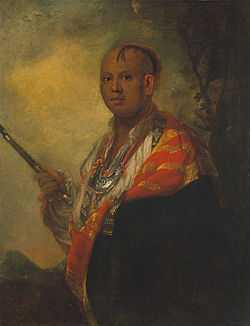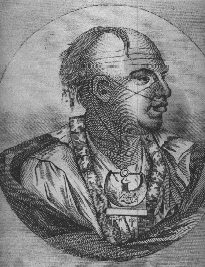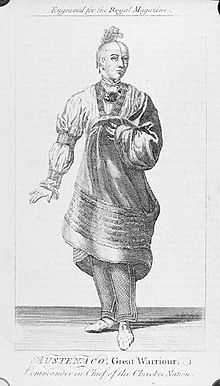Ostenaco
| Ostenaco | |
|---|---|
 Portrait of Ostenaco by Sir Joshua Reynolds, 1762. | |
| Born | c. 1703 |
| Died | c. 1780 |
| Nationality | Cherokee |
Ostenaco (Ustanakwa, or "Big Head"), who preferred to go by the warrior's title he earned at any early age, "Mankiller" (Utsidihi), also known as Judd's Friend, who lived c. 1703 – 1780,[1] was the Warrior (skiagusta) of the Cherokee town Tomotley, residing previously in Great Tellico and probably born in Great Hiwassee, finally migrating in the town of Ultiwa on Ooltewah Creek (in the modern Hamilton County, Tennessee) during the Chickamauga wars. He was known as a great orator and a leading figure in diplomacy with British colonial authorities.
During the French and Indian War, Ostenaco at first aided the Colony of Virginia against the French and the Shawnee, traveling over 3,500 miles on foot and by canoe. In 1756, he led 130 Cherokees in a joint Virginia-Cherokee campaign on the frontier of what is now West Virginia. In 1757 and 1758, his war party raided the French stronghold at Fort Duquesne (present Pittsburgh).[2]
He later turned against his erstwhile allies along with the rest of the Cherokee. He was also involved in the Anglo-Cherokee War and the Chickamauga wars.
Timberlake expedition
The party of Lieutenant Henry Timberlake (including Sergeant Thomas Sumter, an interpreter, and a servant) arrived in the Overhill town of Tomotley on 20 December, where they were greeted by one of the leading men in the town, Ostenaco, visiting from Keowee.[3]
After spending several days in Tomotley as guests of Ostenaco, Timberlake and his interpreter proceeded to the Overhill mother town of Chota, where a number of chiefs had gathered in the town's large councilhouse. Ostenaco gave a speech and ceremoniously buried a hatchet in the ground, symbolizing a state of peace between the English and the Cherokee. Afterward, Timberlake took part in a ceremony in which he smoked several peace pipes with the gathered chiefs, a practice Timberlake personally found "very disagreeable," but participated without openly complaining.[4]

Timberlake and Ostenaco continued southward to Citico, where Timberlake was greeted by a ceremonial dance involving some 400 Cherokee. Timberlake recalled that the dancers were "painted all over in a hideous manner" and that they "danced in a very uncommon figure."[5] The town's chief, Cheulah, presented Timberlake with a string of beads and held another pipe-smoking ceremony. The non-stop pipe smoking made Timberlake so sick that he "could not stir for several hours."[6] The following day, Timberlake and Ostenaco traveled to Chilhowee, the second southernmost of the Overhill towns on Timberlake's map, where the town's chief, Yachtino, held a peace procession similar to that at Citico.[6]
His assignment largely completed, Timberlake returned to Tomotley with Ostenaco on 2 January 1762. Timberlake spent the next few weeks studying Cherokee habits and making notes for his map of the Overhill country. At the end of January, rumors began trickling in from Cherokee scouts of renewed hostilities with rival tribes to the north. Although the rumors turned out to be based on a misunderstanding, Timberlake nevertheless grew anxious and begged Ostenaco to guide him back to Virginia. Ostenaco reluctantly agreed, and the party set out on 10 March 1762. Just before departure, Timberlake witnessed the ceremonial return of a war party led by Chief Willinawaw. The party sang "the war-song" and planted a scalp-filled pole next to the councilhouse door.[7]
The Timberlake party had decided to make the return trip overland, having purchased horses from the Cherokee. Ostenaco, accompanied by several hundred Cherokee warriors, guided the Timberlake group northward across what is now known as the Great Indian Warpath, which follows the western base of the Appalachian Mountains. On 11 March, the party arrived at the abandoned village of Elajoy along Little River in what is now Maryville, and crossed the French Broad River the following day. A week later, they reached Fort Robinson, which the Stephen garrison had abandoned but had left behind a large supply of flour. The expedition left Long Island on 22 March, continuing northward to an abandoned army camp where Timberlake was despaired to find that a trunk containing his belongings had been looted. The party finally arrived in Williamsburg in early April.[8]
Visit to London

While in Williamsburg, Timberlake and Ostenaco attended a dinner party at William & Mary College at which Ostenaco professed his desire to meet the king of England. Although he feared the trip would break him financially, Timberlake agreed. A young Thomas Jefferson, then a student at the college, later wrote of Ostenaco:
"I knew much of the great Outassete (Ostenaco), the warrior and orator of the Cherokee. He was always the guest of my father on his journeys to and from Williamsburg. I was in his camp when he made his great farewell oration to his people the evening before he departed for England. The moon was in full splendour, and to her he seemed to address himself in his prayers for his own safety on the voyage and that of his people during his absence. His sounding voice, distinct articulation, animated action, and the solemn silence of his people at their several fires, filled me with awe and veneration, although I did not understand a single word he uttered."[9]
In May 1762, Timberlake, Sumter, and three distinguished Cherokee leaders, including Ostenaco, departed for London.[10]
Arriving in early June, the Cherokee were an immediate attraction, drawing crowds all over the city. The poet Oliver Goldsmith waited for three hours to meet the Cherokee, and offered a gift to Ostenaco.[11] They sat for Sir Joshua Reynolds to take their portraits,[12] and they met personally with King George III.[13] The Cherokee returned to North America with Sergeant Sumter on about 25 August 1762.[14]
During the American Revolution
During the Second Cherokee War, part of the American Revolution, Ostenaco was the chief war leader of the Cherokee Lower Towns in western South Carolina/northeast Georgia, and in 1776 led their attack against the Province of Georgia. After the destruction of the Lower Towns in the retaliation which followed, Ostenaco led his people west. The majority resettled in what is now North Georgia, with Ustanali as their chief town, but some followed him into the Chickamauga Wars (1776-1794) with Dragging Canoe, and settled with him in the Chickamauga (now Chattanooga, Tennessee) region at the town of Ultiwa (Ooltewah).
He died at the home of his grandson, Richard Timberlake (son of Henry Timberlake and Ostenaco's daughter), at Ultiwa in 1780.
References
- ↑ Stuart, John (21 July 1767), Letter to Thomas Gage
- ↑ Wood, "Ostenaco"
- ↑ Henry Timberlake, Samuel Williams (ed.), Memoirs, 1756–1765 (Marietta, Georgia: Continental Book Co., 1948), 57–58.
- ↑ Timberlake, Memoirs, 59–61.
- ↑ Timberlake, Memoirs, 63.
- ↑ 6.0 6.1 Timberlake, Memoirs, 65.
- ↑ Timberlake, Memoirs, 109–113.
- ↑ Timberlake, Memoirs, 118–129.
- ↑ Francis W. Hirst, Life and Letters of Thomas Jefferson, 16
- ↑ Timberlake, Memoirs, 130–133.
- ↑ Timberlake, Memoirs, 136.
- ↑ St James Chronicle, 3 July 1762.
- ↑ Timberlake, Memoirs, 143–144
- ↑ Timberlake, Memoirs, 145–147.
Sources
- Evans, E. Raymond (1976), "Notable Persons in Cherokee History: Ostenaco", Journal of Cherokee Studies (Cherokee: Museum of the Cherokee Indian) 1 (1): 41–54
- Timberlake, Henry; Williams, Samuel, eds. (1948), Memoirs, 1756–1765, Marietta, Georgia: Continental Book Co.
- Wood, Douglas McClure, "Ostenaco," The West Virginia Encyclopedia